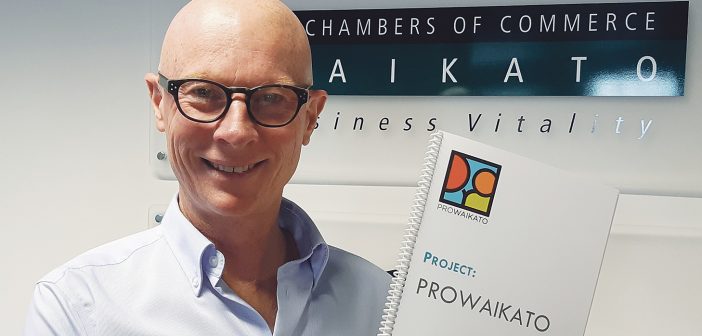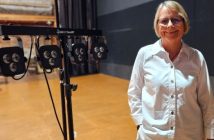Waikato Chamber of Commerce chief executive Chris Simpson is promoting a blueprint called Pro Waikato, charting a path forward until 2030.
It includes five “cultures”, with opportunities and actions for each one. They are Business and Community, Information, Rates and Development Contributions, Transport and Best Business Services. The blueprint describes the future as fast changing and dynamic and says: “The real opportunity for the Chambers (on behalf of business) is to make sure that the solutions are in place so Waikato can benefit from the disruption that is rapidly becoming the norm.”
Chris Simpson answers 10 questions from Waikato Business News.
Why a blueprint now? It’s pretty simple – demand and supply. We are probably going to see a bigger migration by business and people to Waikato when the expressway opens. So, with the Waikato expressway about to open fully and the rapidly changing face of commerce, the most important thing that we can as an advocacy body is to push for what we want. We are 113 years old, and we must show leadership about what we, as business, need. And what we believe local and central government must work towards to deliver the most productive and profitable business community. So, we think the time is now, before the expressway dumps Auckland on our back doorstep.
Where are you at with the process? We are currently going out to our members checking with them what they see the next 10 years as delivering. We don’t want to write a blueprint that is esoteric and ambiguous. The blueprint must be exactly that, a blueprint that we will follow to deliver on a prosperous future for all Waikato business people, entrepreneurs and people who have jobs in our industries.
Who do you envisage being on the proposed action group to deliver the cultures of purpose? Leaders from the IT, property, logistics and HR world will be key movers on this. Also, capital in the form of banks and venture capitalists – they must be represented. It’s about getting the balance right of place, people, and money. Otherwise if it’s not done in unison, the blueprint will become nothing more than a glorified coffee table magazine. However, it must have a driver that’s based on what’s good for ensuring we can deliver profitable and sustainable business here in Waikato.
In Culture 1, you refer to a “reforecasting of councils’ long-term plans to reflect the issues and opportunities facing business in Waikato”. This seems to suggest you think they are not doing that at the moment. What needs to change and how will you work towards that? Yeah, good question. You only have to look at Hamilton and the productivity of the city is going backwards, something like -0.2 percent in 2018. So, no, we don’t think they are at all and it’s important that we in business, in a collective way, point out where things can be done better through planning. Which is why it’s important that we bring the right people to the conversation with councils.
In general, there are a lot of areas in the blueprint that involve local government. How do you intend to work with councils to achieve your goals? With about 12 councils that we have to deal with in the area, it is all about working with them. However, we are looking at taking it a step further. We will push a conversation about local body amalgamation. It seems nuts to have so many councils and a regional council for only 500,000 people. There must be a better way, and it’s a better way that we want to tease out through this Blueprint.
You refer to pushing for local body amalgamation where appropriate. The government has ruled out local body amalgamation and mayors were not receptive when you raised this a few months ago. Is it a dead duck? This government has ruled it out. But, this government also will listen to the will of the people. So, a proper campaign that is well thought out and shows them where there is opportunity for Waikato is something we must push. And, if this government doesn’t do anything, well, approx. every 1095 days there’s a new general election, so we will get a government in the future to agree with us! After all, with this one we have history on our side.
When it comes to Culture 2, you want “proper analysis, analytics and an open source Waikato digital platform to share data with the end user in real time” as an achievement for the first year. That’s a tight timeframe – how will you achieve this? It is a tight timeframe, and it’s a timeframe that needs to be the focus. The best way to deliver on data like this is to work with both central and local government to see where we can work together to pull this data through for us here in Waikato. There are also opportunities to bring our members into providing relevant data which will help them make better investment decisions. Is it pie in the sky? Well, based on what we need for tomorrow re better information and analytics, the question will be how do we do it – and that’s something that must be pushed.
You refer to creating a “G3” Economic Development Zone, between Auckland, Waikato and Tauranga/Bay of Plenty. Who do you envisage being part of this group? And how do you see it being set up? This is where the Chambers of Waikato, Auckland and Tauranga have strength combined. It’s how we leverage our international connections and our membership to the International Chambers of Commerce to bring good ideas and investment to all three of our areas. And, because we aren’t council/government funded, it’s something that we can do in a very nimble and expedient way.
Who do you see being involved in a Waikato infrastructure and business committee under Culture 3? And your suggested Waikato infrastructure/rates committee? If that includes councils, how will you encourage their involvement? This one is the key. By infrastructure, we don’t just mean roads, we mean IT. And the people and organisations that will be involved here must be from the logistics and export sector. A keen focus here is on how we can help both drive better productivity in our region, as well as getting practical advice from this committee which we can share and engage with at an international and local level. Either with our members/business, or with government and local government.
Do you see the Waikato Municipal Endowment Fund working quite differently from the current Hamilton Endowment Fund? Great question – yes, very much. It’s how we direct local government and their strategic property arms to think about where they will get the best investment return for their bucks. Again, we need the right analytics and people involved to help steer the conversation as to where the best investment should happen. And the current Hamilton endowment fund, well, a lot of that is sitting in a bank account offsetting debt. That’s not what the Act of Parliament says it should be doing. So, we must advocate better investment choices for councils.





